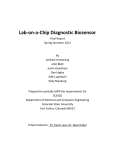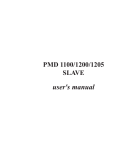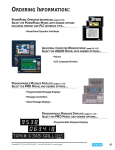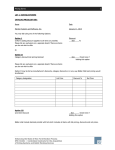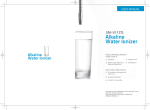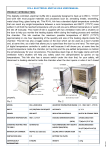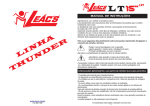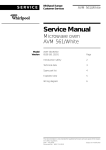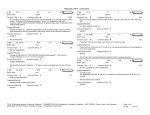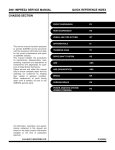Download Recommendations for Future Work
Transcript
Recommendations for Future Work Microfluidics The microfluidics mask design provided fully functional fluid flow for both passive and active methods, although finding a solution to why fluid will not flow passively on a chip remains to be investigated. As described previously, there were complications in achieving a permanent bond with plasma oxidation on the most recent, working chips for reasons not completely understood. It is possible that obtaining a better understanding of the differences in surface chemistry between the old and new chips would explain this phenomenon. In the future, having a new mask design with either 0.8 mm reservoirs or with the reservoirs completely removed would be convenient to have as different fluid flow methods require different sized punches. For example, active flow using PEAK tubing requires a 0.8 mm punch on each end of the channel while passive flow requires a 1.5 mm inlet reservoir and a 1.0 mm outlet reservoir. Another potential area for future work in the design and integration of microfluidics lies in simulations. It would be helpful to use a program like Fluent to simulate the flow patterns. In addition, in conjunction with the apparatus setup, it would be useful to gain more insight into the temperature changes incurred by lengthy exposure to the microscope light during positioning and how long it subsequently takes for the device to return to room temperature. In the distant future, it will be necessary to devise a reconfiguration of the probe station to accommodate fluid flow through several channels for sample delivery to multiple sections of a waveguide. Finally, in conjunction with work on biomolecules and antigen-antibody bonding, calculations and experiments should be conducted in an attempt to determine approximate diffusion and kinetics properties of tuberculosis molecules between the microfluidic channels and the waveguide surface. Biomolecular Printing Biomolecular printing still needs to be improved for use in the LEAC chip system. Due to the inability to use the electronic printer, the PMDS punch printing method has the greatest likelihood for success in this system. This method however still offers problems that need to be addressed for full system integration to be possible. The accuracy and repeatability of the alignment of the two printing step is crucial for this method to allow for reliable data to be taken from the LEAC chip. A more consistent method for creating the first dimension printing pattern would increase accuracy greatly. A mask design and mold for this piece of PDMS, with the reservoirs measured out to exactly correspond with the widening in the channels would be a large improvement on the previous method of marking the areas with a permanent marker. This would allow for precise punches for the first dimension printing that correspond directly with the second dimension channels. It would still be very important to ensure that the two PDMS stamps are aligned with each other when they are put onto the chip. The aligner makes this accurate, but practice and perhaps improvement in this technique would improve alignment. Another, and potentially more detrimental problem, is that of the inability to permanently bond PDMS to surface with biomolecules already attached. It was found that in order to use the syringe pump and tubing system a permanent bind between the PDMS and the LEAC chip was important. The tubing system will pull PDMS that is not permanently bound off of the LEAC chip, and for real-time data, it is imperative that the second dimension PDMS channels stay attached. However, to get a permanent bind between PDMS and a chip, both surfaces need to be placed in the plasma chamber, which is impossible with the previously printed first dimension of antigens. The plasma treatment would ruin the first dimension patterning. Unless a way to avoid a need for permanent binding within the system is discovered, this problem may be cause for finding a new form of microfluidic channels that does not involve PDMS stamps. Probe Station Future work on the probe station should make the system as a whole more user friendly and easier to align and manipulate. The recent addition of translation stages under the fiber launch and probe card attempted to meet that need but are lacking in some ways. The translation stage under the probe card is probably a good solution for that particular part, however, the translation stages under the fiber launch are rather slow moving and difficult to reach. In addition, the sample holder is still not fixed to the base plate of the probe station. Using rail type control stages may be a good way to provide the desired freedoms and make the station more usable. The advantage of rail type control stages is that they are quicker and easier to adjust and generally have an increased range of travel compared to micrometer controlled translation stages. One possible configuration would be to add one rail type control stage under the sample holder and another under the fiber launch. The one under the sample holder would be used for coarse adjustment in the Y direction of the sample to the fiber. The one under the fiber launch would allow coarse X direction adjustment. Fine adjustments would then be performed using the micrometer controlled XYZ capability of the two pieces. The other probe station problem that should be addressed by future work is accessing waveguides 2 and 6. As detailed in the probe station user’s manual, the current probe station hardware cannot access these two waveguides on a PDMS bonded LEAC sample. This is due to the configuration of the LEAC sample contact areas, waveguide entrances and probe card probes. To allow the various pieces of hardware to fit in Configuration 3 as defined in the probe station user’s manual, the fiber launch should be adjusted in such a way that makes part of it lower with respect to the plane of the probe card and sample. However, part of it will still need to be at the same height as the sample to allow coupling of the laser into the waveguide. This would allow the fiber launch to sit under the probe card safely while retaining the necessary function. LabVIEW Programming LabVIEW is a powerful tool that can interface with hardware devices, automate experiments, and capture data. There are many things that can be done in the future to help with the program moving forward. However, the best approach would probably be to start the program over from scratch. The program used was based on LabVIEW 8.5 which is a fairly old version. Unfortunately this version has caused the program to no longer open correctly when used with any version of LabVIEW 2011. After getting a feel for the sort of experiments and forward progress that wants to be made, the biggest choice that will be made is what kind of data the group wants captured through the program. There are a few key components, in which the user interface needs to give the user meaningful real time data, the program needs to save data in a useful format, and the code should be combined with MATLAB to automate data processing (Perhaps it should be looked into not using LabVIEW at all and interfacing to the devices with MATLAB). An addition that needs to be added to the LabVIEW control interface is a manual, real time selection of channels. As of now a person can only sweep through channels, making it cumbersome to debug individual pads or probes. The reference channel logging is also currently inoperable and needs to be fixed. Currently when the program logs the reference channel measurement it only saves it to the nearest integer, removing any usefulness. Finally, a feature should be added that displays a graph with the history of the channel that can be used to compare with the current channel so that drift can be observed in real time and adjusted for accordingly. Saving the data in a useful format is another consideration. It is important that all of the raw data is saved for the entire run, not just the mean and standard deviation. Any future revisions of the code will need to ensure that all data is saved in a coherent manner for both the signal channels and the reference channels if used). The last and possibly most major improvement would be the incorporation of MATLAB '.m' files as blocks within the LabVIEW interface. It could then handle the data directly and process it in real time enabling the user to know the results of the experiment as it is happening. This would allow for better response to experimental setup errors as well as save a lot of time that is currently needed for data manipulation and analysis after the experiment has already been completely performed. Multiplexing/Amplification Circuit The current multiplexer and amplification circuit appears to be working great and probably does not need any revisions done to it until other parts of the system are developed more. One modification that may want to be made is the inversion of the amplification circuit. In order to achieve this, the jumper must be placed on the board and pin 1 of IC2 needs to be lifted up from the board (See Figure 0-1). This will result in increasing voltages for increasing currents which may make data collection more straight forward. The PCB design solved most of the problems encountered early on in the year. The schematic is located in Appendix F as well as in electronic form in the lab on the senior design CD. Any future revisions of the probe card should be made by modifying the current schematic and PCB design in Advanced Circuits PCB artist. Figure 0-1: Schematic of location of PCB that needs to be modified to invert circuit A future revision of the circuit might want to attempt to place the amplifier portion of the circuit before the multiplexing. This would remove the large time constant issue of the amplifier having to change to the different channels signal levels, as well as eliminate any possible MUX noise from being amplified. Lastly, it would be beneficial to incorporate the lock-in amplifier set up as discussed in Section II. This would allow for the direct measurement of the photocurrent and may remove a lot of confusion associated with changing dark currents. Probe Card There are a few things which could be investigated in the future related to the probe card, but these are unlikely critical to the project. One of the things which could be first investigated, if it is shown to be necessary, is looking into how to fix the currently bent probes on the probe card. These seven probes were inadvertently bent during testing and lie in the middle of the set of probes. They correspond to the middle of a set of photodetectors for any waveguide on the LEAC chip. Thanks to the redundancy of the LEAC chip, it is not imperative that these probes get fixed in order to collect useful data. However, if data on more channels, or data on the currently inaccessible channels is desired, fixing these probes should be investigated. The vendor through which this probe card was ordered says that, if the probes are not too bent, they can unbend them and if not, they can simply replace the broken ones. They also said that the cost of this is determined largely on a case-by-case basis. If more knowledge of how much this would cost is desired, the vendor should be contacted again and probably sent pictures of the broken probes. An important thing to keep in mind with the probe card is that its probes require periodic cleaning in order to maintain function. Currently, the probes on the probe card are tungsten probes which are relatively fibrous and prone to collecting oxides from the aluminum pads they connect to. When a significant amount of oxides or other debris are collected in the probes, it can destroy functionality and consistency of testing. To fix this, the probes should be cleaned when contact issues are a noticeable problem or noisy data on channels that used to not be so noisy becomes apparent. There are a few easy ways to clean these probes. One is by rubbing 3 microns grit, silicon type lapping paper (like sand paper) across the probes to dislodge oxide. This was the only method used for cleaning the probes previously and seemed to work fairly well. If a different method is desired, or this one proves to be ineffective sometime, one should contact the vendor to determine what to do. If a new probe card is ever ordered, there are a few things which could be done differently and would possibly be beneficial. The first is changing the type of probes from tungsten to tungsten-rhenium. Tungsten-rhenium probes are less fibrous and not as prone to collecting oxides as tungsten probes. This means they require less time between cleaning and possibly last longer. Another thing which should be investigated is the exact location at which the edge sensors are placed on the probe card. Currently, they are sometimes close to coming in contact with a waveguide on the LEAC chip when they are set down. It is very undesirable to come down with a probe on one of the fragile waveguides. Avoiding this is relatively simple, since the waveguides are so small, but to make sure this does not happen if a new probe card is ordered, other positions should be looked into. Team Management One hindrance to the project’s progress this past year was the learning curve for the new team members and the time it took each to get up to speed on the theory, technology, and laboratory techniques required by the device. It would be useful to spend the first month or two reading papers, presenting materials, and learning basic science techniques in the laboratory as opposed to learning them haphazardly and individually along the way. In addition, while experiments are critical to progress, it would have been useful to the validation of conclusions if the experimental work were supported by analytical solutions and simulations. In terms of weekly meeting times, revisions should be made to the team meeting structure to yield more efficient communication and progress. While it is still relevant to alternate team leadership responsibilities, it would be useful for all team members if more formal presentations of results were required at weekly meetings and all deliverables included with weekly progress reports. It might also be useful to move these meetings from the middle of the working week to the very beginning in order to more clearly define goals and strategies for each week. The Gantt chart was useful and should remain an integral component of the project management. Finally, if the team is to remain interdisciplinary, recruitment of advisers from the chemical engineering and the mechanical engineering departments could provide invaluable advice and support.





